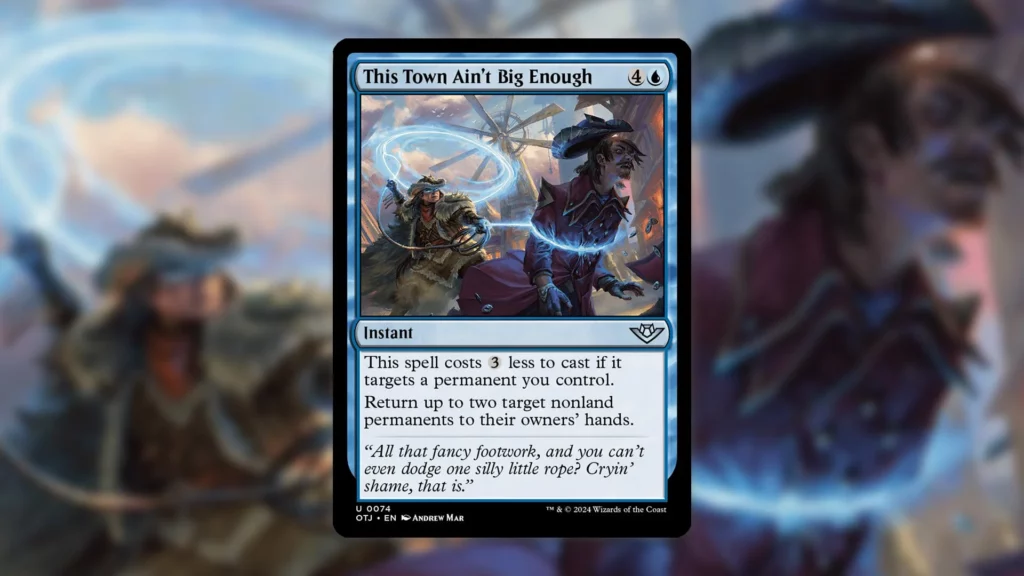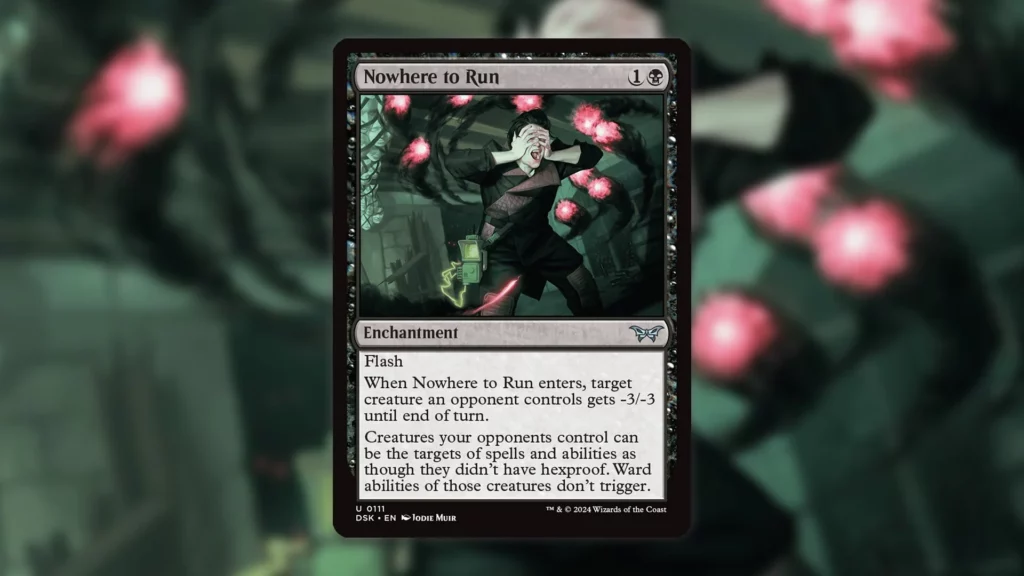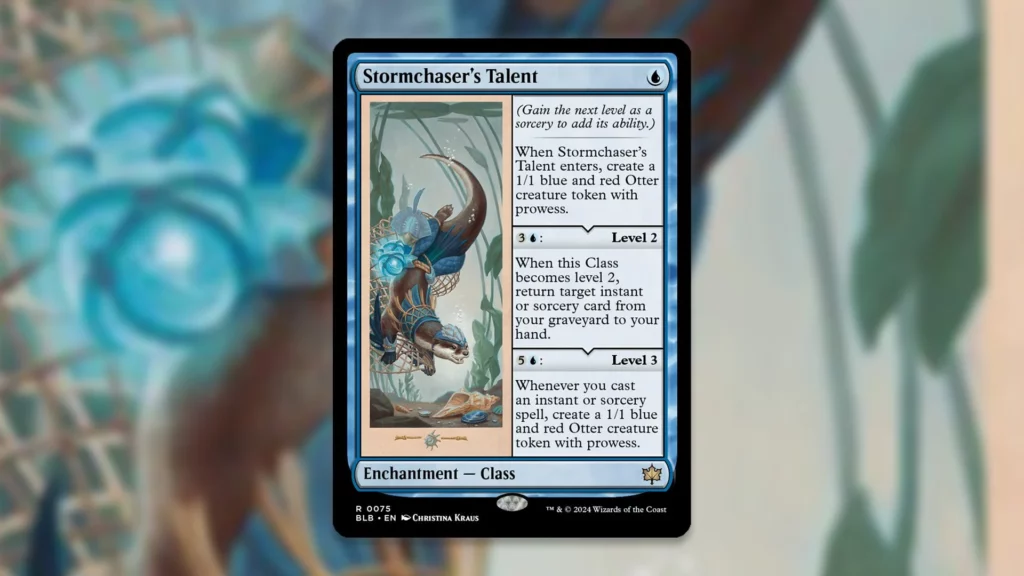Over the past couple weeks, we’ve seen a lot of different flashy Aetherdrift cards make a splash in Standard. Some players have had success with Howlsquad Heavy in mono-red Goblins. Others have turned to Oildeep Gearhulk as a great piece of top end in Dimir midrange. There’s clearly a lot of room for exploration with the new cards.
Unfortunately, though, one archetype continues to maintain its chokehold on the format. This deck is capable of applying early pressure, grinding through opposing pieces of interaction, and even has built in inevitability. The deck was a staple of Standard prior to Aetherdrift, and despite not receiving anything super pushed in the way of upgrades from Aetherdrift, still remains the best strategy in Standard by a wide margin.
We are, of course, talking about the self-bounce archetype. Whether you’re playing Esper or simply Dimir, the combination of Stormchaser’s Talent and This Town Ain’t Big Enough runs rampant in Standard and is extremely difficult to fight against. Some players are even calling for bans, and frankly, we believe a ban is the best thing for Standard moving forward.
Difficult to Gameplan for

The duo of Stormchaser’s Talent and This Town Ain’t Big Enough may not look super scary at first. After all, a 1/1 with Prowess for one mana isn’t necessarily all that impressive. Neither is bouncing two nonland permanents, one of which has to be your own, for two mana. The problem is that, when both cards are built around, they can completely take over the game.
Let’s start by looking at Stormchaser’s Talent. Stormchaser’s Talent is one of the scariest cards to see on turn one in the format. This is because there are a multitude of follow-ups, including This Town Ain’t Big Enough, Nurturing Pixie, and Fear of Isolation, that essentially generate free value by returning Stormchaser’s Talent to your hand.
The curve of turn one Talent, turn two Pixie, bounce Talent to your hand, and replay it puts a ton of pressure on the opponent. You’ve only played two nonland cards, and yet the opponent is already under the gun. Whether the opponent is playing a red aggressive deck or a black midrange deck, they’re now put in a bind.
Spending time and effort killing Stormchaser’s Talent tokens with Cut Down and such simply isn’t a favorable exchange. This is because any copies of Pixie or Fear you play essentially puts two threats into play, since you’re bouncing Stormchaser’s Talent and replaying it in the process to flood the board with more tokens.
At the same time, using enchantment removal like Tear Asunder to handle the copies of Talent themselves isn’t a winning line either, since the opponent will just get beaten down by the tokens in the interim. So, the best bet is often to apply pressure themselves and try to race, since winning on the card advantage front is extremely difficult.
This is where This Town Ain’t Big Enough becomes a massive beating. The card not only staves off pressure from the opponent, but it generates value by bouncing any of your enchantments with an enters-the-battlefield effect at the same time. This alone makes fighting self-bounce decks in Standard a massive struggle.
Inevitability

Yet, this is far from the only line of play the powerful uncommon instant provides. Say your opponent has a fast red aggro draw and you don’t have Stormchaser’s Talent in your opening hand. There’s no need to fret. Cards like Nowhere to Run and Grim Bauble can easily trade one-for-one in the early turns to buy you time.
Well, now This Town becomes the ultimate control option. These removal spells sit in play, and if you ever find a window to bounce them both back to your hand with This Town, you will easily pull ahead.
This doesn’t even take into account the fact that eventually, once you find Stormchaser’s Talent, you have inevitability. Level 2 of Stormchaser’s Talent lets you buy back This Town from your graveyard. You can then cast it, bounce Stormchaser’s Talent, and replay the enchantment with the intention of getting to Level 2 all over again. This late-game loop means that even if you’re flooding, the opponent is still in a world of trouble.
The Case for a Ban

This level of versatility is why, in our eyes, a ban to This Town is in the best interest of the format. This archetype’s “nut draws” involving Stormchaser’s Talent are capable of racing every other deck in Standard. Even Domain, which is one of the few decks in Standard with a solid matchup all around, can easily lose to a fast draw.
If you know you’re facing Domain, you can mulligan more aggressively for Stormchaser’s Talent and Optimistic Scavenger try to run them over. Yet, if you’re playing against decks with less brutal top-end monsters, your removal suite combined with This Town can take over games on their own.
From a gameplay perspective, This Town is good against everyone and has become ubiquitous as a result, which is a huge argument in favor of this card specifically eating a ban. From a diversity perspective, Dimir and Esper self-bounce combine for 21% of the metagame according to MTGGoldfish. These decks consistently perform well in big events, too, with Esper Pixie taking up four of the top eight spots in the most recent Magic Online Standard Challenge.
Furthermore, multiple players believe self-bounce decks will make up 40%+ of the Pro Tour Aetherdrift metagame this coming weekend, suggesting that the deck is currently underplayed. Some players are even hoping that the deck dominates the Pro Tour so there’s a higher likelihood of This Town getting the axe.
We think there’s a really good chance the 40% estimate will prove to be far from an exaggeration. The Domain matchup may be a slight concern, but that deck is largely held in check by Prowess shells that are popular in their own right.
Self-bounce is super powerful, and the play patterns associated with This Town are unenjoyable. This Town’s ability to temporarily answer any nonland permanent makes it much harder to play exciting, clunky build-arounds as well. A ban to This Town feels like the best way to keep the format fresh and games more interesting.

